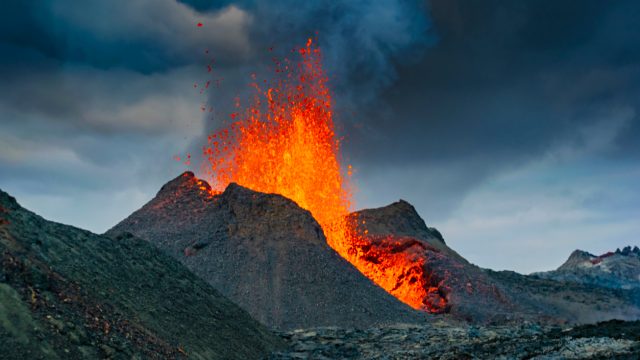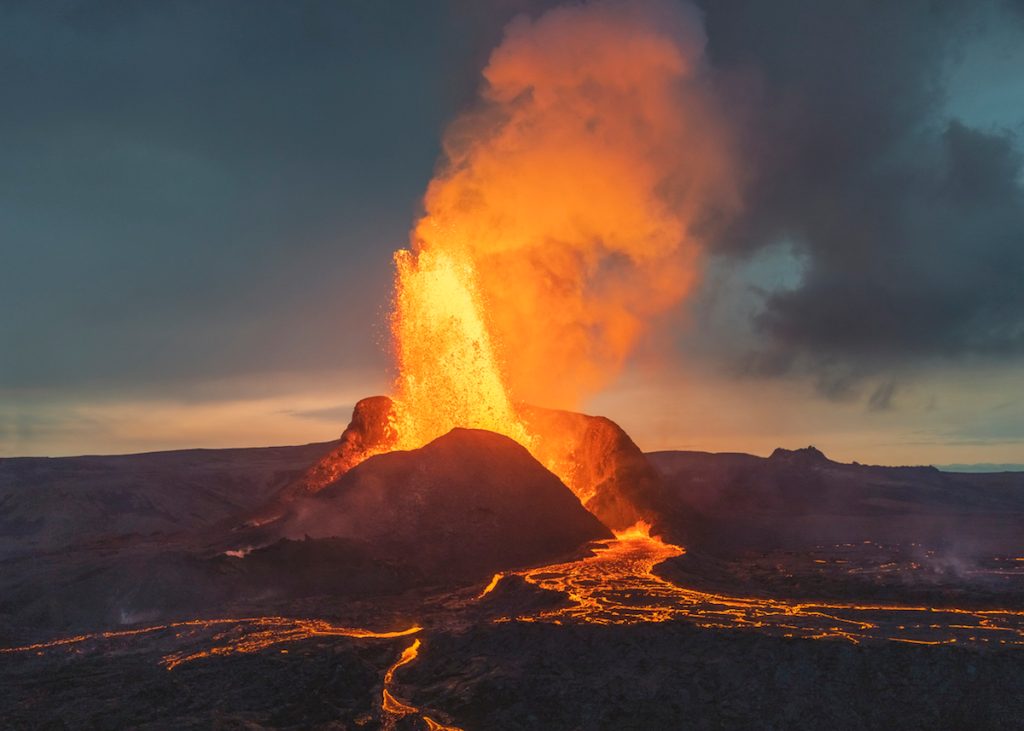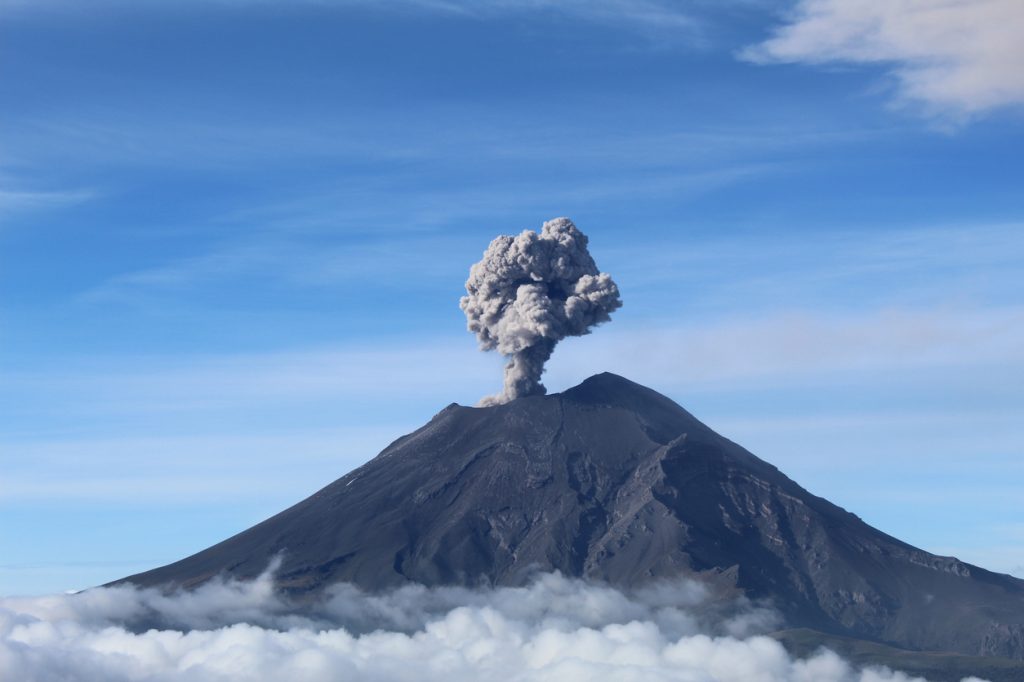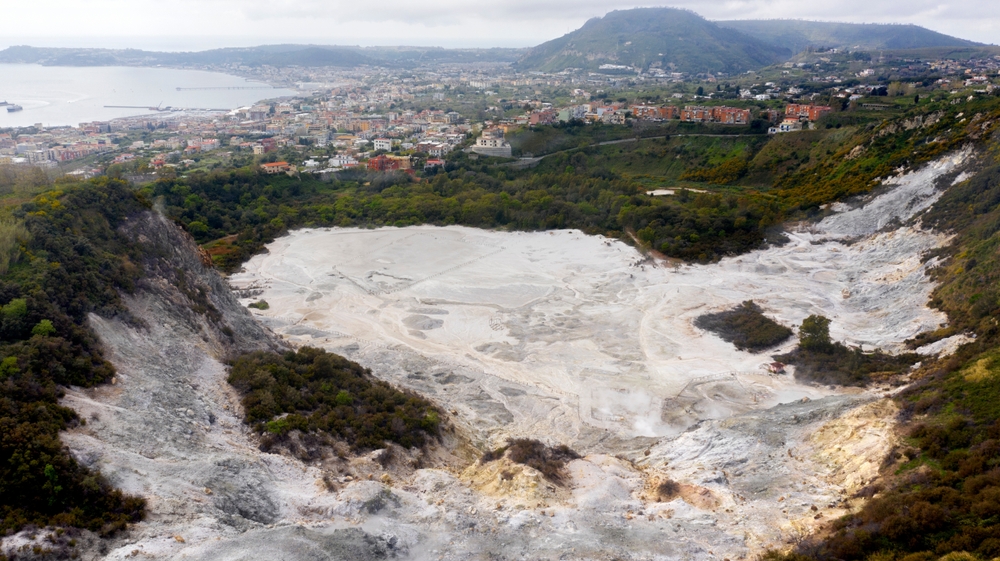Why Popular U.S. Vacation Spots Are Seeing More Volcanic Activity Suddenly

The sheer force of a volcanic eruption is never something to be taken lightly. The cataclysmic events can lead to the tragic loss of human life, widespread destruction of nature, and cause long-lasting or permanent damage to the areas they affect. While nothing can be done to stop them, scientists still pay close attention to any sites that begin showing rumblings or other potential warning signs—including within the U.S.—as even a single event can have a large-scale impact. And now, volcanic activity is suddenly rocking four popular vacation spots around the world, with some showing signs they could soon escalate. Read on to see if major eruptions are overdue in these places.
RELATED: Major Hurricanes Intensifying, New Data Shows—Is Your Region in Harm’s Way?
Iceland is bracing itself for a potential volcanic eruption near a famous landmark.

Iceland’s famous natural beauty draws in tourists from around the world looking to take in the country’s breathtaking sights, relax in hot springs, and potentially catch a glimpse of the Northern Lights. But as the “Land of Fire and Ice,” it’s also no stranger to fairly regular volcanic activity that has helped define the island nation’s landscape. And now, a surge in volcanic activity has some concerned another major eruption could be imminent.
This past weekend, a flurry of thousands of earthquakes on the Reykjanes Peninsula in the southwest corner of the country led to the evacuation of the town of Grindavík amid fears that a magma plume may have risen just below ground there, National Geographic reports. Photos of the seaside village now show large steaming fissures that have torn apart streets and buildings. Local officials have since taken action to protect the nearby Svartsengi geothermal power plant, and the famous tourist landmark Blue Lagoon has temporarily closed to visitors and shuttered its hotels through at least Nov. 23, according to its website.
The latest eruptions come after a series of volcanic events that have shaken the area since March 2021. The latest occurred this past July with a month-long eruption at another fissure, National Geographic reports. And while the previous events tipped them off that more eruptions would likely follow, scientists and local officials are now anticipating what could happen next. Data suggests a potential eruption site that spans 11 miles, including within Grindavík, the surrounding areas, and a small area just beyond the coastline under the ocean.
“At this moment, it is not possible to determine when or where an eruption might occur,” the Icelandic Meteorological Office said in a statement on Nov. 13, per USA Today. “The Icelandic Meteorological Office, Civil Protection, and a team of scientists from the University of Iceland are closely monitoring the situation and analyzing the developments.”
RELATED: The 10 Riskiest U.S. Cities for Natural Disasters, New Research Shows.
A volcano in Mexico began spewing a column of ash amid concerns lava flows could follow.

Meanwhile, the Popocatépetl volcano in Mexico also showed signs of mounting activity. According to a release from the Volcanic Ash Advisory Center in Washington, the mountain released an ash plume that rose as high as 20,000 in altitude.
As a result, the National Disaster Prevention Center in Mexico said it had set the Volcanic Alert Traffic Light for Popocatepetl to “Yellow Phase 2” for at least 24 hours, which indicates that the volcano is becoming more active and that lava flows are possible. The agency also urged people to stay at least 12 kilometers away from the mountain and its crater as it continues to release dangerous gases and red-hot materials that could cause serious or fatal injury.
The latest activity comes after the volcano, known to locals as “El Popo,” showed signs of life in May. A major event at the site could affect more than 22 million people who live in the surrounding area, according to the Associated Press.
RELATED: Intense Solar Storms May Peak Faster Than Expected—What That Means for Earth.
A caldera near Naples, Italy, is causing concern as it becomes more active.

Italy has long dealt with active volcanoes in its midst, from the historic eruption of Mt. Vesuvius that destroyed the city of Pompeii in 79 CE up through today. The latest incident involves the Campi Flegrei, an eight-mile-wide caldera in Naples that is currently experiencing an increase in seismic activity and ground swelling, creating concern that the site could experience an eruption, The Guardian reports.
According to reports, the area recorded more than 1,100 earthquakes throughout September, with some reaching magnitudes as high as 4.0 and 4.3. The site is also seeing what’s known as “positive bradyseism”—which describes when the ground is forced upwards by shifting magma—with conditions currently showing a rise of more than half an inch per month, per The Guardian.
On Oct. 5, Italy’s civil protection agency released an updated evacuation plan for the city that could move more than half a million people out of harm’s way within a 72-hour window, CNN reports. However, locals fear crushing traffic on local roads would make the plan less effective. The caldera’s last eruption in the early ’80s saw 40,000 people evacuated.
In a study published in June, scientists concluded that ground movement could be weakening parts of the volcano and making an eruption more likely—but that nothing was for certain.
“Campi Flegrei may settle into a new routine of gently rising and subsiding, as seen at similar volcanoes around the world, or simply return to rest,” Stefano Carlino, a volcanologist from the Vesuvius Observatory and coauthor of the study, said in a statement accompanying its release. “We can’t yet say for sure what will happen. The important point is to be prepared for all outcomes.”
Volcanic activity in Japan created an entirely new island offshore.

While volcanos are often destructive, they also have the power to create. This was the case following a recent eruption in Japan, which made a new island appear roughly a half mile off the coast of Iwo Jima, the Associated Press reports.
The newly formed landmass came to be following more than a week of buildup of volcanic rock and ash spewed from an undersea volcano that began erupting on Oct. 21. As of Nov. 9, the brand new island was already roughly 328 feet across and topped out at 66 feet above sea level, per the Japan Meteorological Agency.
However, scientists warned that it might wash away nearly as quickly as it appeared. “We just have to see the development,” Yuji Usui, an analyst with the Japan Meteorological Agency, told AP. “But the island may not last very long,” pointing out that the “crumbly” makeup of the landmass made it susceptible to waves and heavy seas.
RELATED: For more up-to-date information, sign up for our daily newsletter.